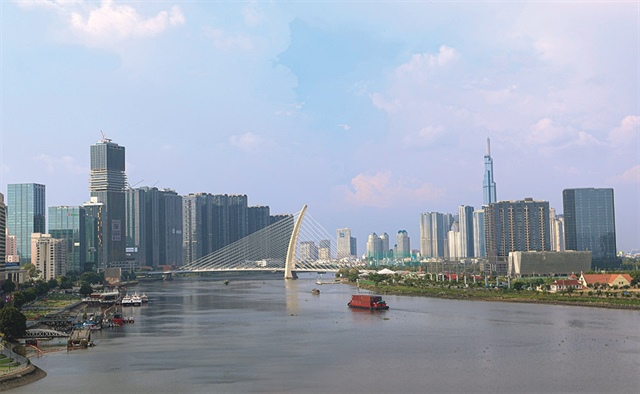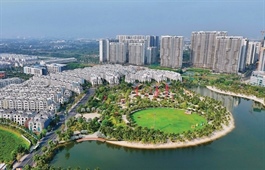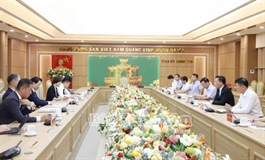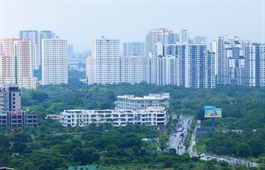Merger sets stage for south property boom
Merger sets stage for south property boom
The integration of former Binh Duong and Ba Ria–Vung Tau provinces into Ho Chi Minh City, paired with sweeping regional planning initiatives, is anticipated to open a new chapter of growth in the real estate sector, with large-scale urban projects drawing widespread investor interest.
Starting July 1, Ho Chi Minh City officially transitioned to a two-tier government model, integrating its development space with neighbouring Binh Duong and Ba Ria–Vung Tau.

Merger sets stage for south property boom |
This marks a historic milestone, paving the way for a regional mega-city with an economic scale exceeding VND 2.7 quadrillion (approx. $110 billion), equivalent to nearly one-quarter of Vietnam’s GDP.
Amid this transformation, the real estate market, particularly in the northeastern corridor of Ho Chi Minh City, is seeing strong momentum. The apartment segment, in particular, is emerging as a magnet for investors, contributing to a more modern and liveable urban landscape, according to Dr. Can Van Luc, a member of the Prime Minister’s Economic Advisory Council.
Speaking at a July 12 seminar on the topic, Luc said that Ho Chi Minh City now holds rare advantages and opportunities to become a modern, regional and international mega-city.
“The city boasts the largest population and land area in the country, accounting for about 2 per cent of Vietnam’s territory and 13.5 per cent of its population. It is positioned as the nation’s leading economic, financial, industrial, and technological hub,” Luc said.
Simultaneously, the city is making major investments in multimodal and modern infrastructure. A range of key projects, including metro lines, Bus Rapid Transit systems, expressways, and high-speed rail, are taking shape, forming a comprehensive and highly connected transportation network at local, regional, and international levels.
In addition to transport infrastructure, Ho Chi Minh City is also accelerating the development of new urban areas aimed at supporting a multi-centered urban model.
“With its combined strengths in scale, policy direction, economic capacity, infrastructure, and technology, Ho Chi Minh City is on the cusp of a powerful breakthrough, well-positioned to become a premier mega-city and the dynamic growth engine of the nation,” Luc stated.
Poised for growth leap
According to Nguyen Van Dinh, vice chairman of the Vietnam Association of Realtors, the merger is expected to catalyse a new growth phase in the real estate market, marked by the emergence of large-scale, high-quality projects.
“The product structure is also set to diversify and adapt to a reshaped and growing market. This transition is seen as a window of opportunity for both domestic and foreign investors,” Dinh said.
Currently, Ho Chi Minh City’s population has surpassed 14 million. Post-merger, the regional economy is expected to contribute roughly one-third of state budget revenue and over one-fifth of Vietnam’s total import-export turnover.
“These impressive figures not only underscore the city’s role as an economic locomotive but also provide a psychological boost for market confidence,” Dinh said.
However, the benefits of the merger will not be evenly distributed. Only areas with solid foundations in infrastructure, economic activity, and population attraction will see a meaningful impact. The northeastern region of the city stands out as a key beneficiary.
As regional restructuring and master planning expand, northeast Ho Chi Minh City is undergoing visible transformation. The industrial real estate segment is being restructured to meet modern standards, thereby attracting foreign investment and forming clusters of skilled labour, professionals, and engineers. This is driving demand for high-quality housing.
“However, good infrastructure alone doesn’t guarantee successful real estate investments,” Dinh added. “In a market entering a phase of significant filtering, selecting the right project is essential not only for capital safety but also for long-term profitability.”
With abundant land reserves, the area is expected to host master-planned residential projects with transparent legal frameworks, green features, smart technologies, and premium amenities. According to Dinh, the apartment segment is poised to lead the market in the near future, particularly mid- to high-end apartments catering to affluent residents in emerging financial and high-tech hubs.
Southbound migration
The merger comes at a time when the northern real estate market has passed its peak growth phase and is showing signs of saturation in investor appetite.
This has triggered a noticeable southward shift among major real estate brokerages and investors from northern Vietnam. Many are eyeing large-scale apartment projects with integrated infrastructure and planning, especially in the city’s northeastern region.
This southbound trend not only affirms Ho Chi Minh City’s economic leadership but also reflects the growing appeal of real estate projects priced according to intrinsic value. Many investors have already positioned themselves to ride the next market wave, recognising the long-term potential of the northeast Ho Chi Minh City market.
According to data from batdongsan.com.vn, as of March, up to 66 per cent of Hanoi residents surveyed expressed interest in the southern real estate market.
Outlying areas and satellite markets of Ho Chi Minh City, such as the former provinces of Binh Duong, Long An, Dong Nai, and Ba Ria-Vung Tau, are drawing increasing attention from Hanoi-based property seekers.
Among the segments most favoured by Hanoians in their southbound investment trend, apartments lead with 75 per cent of respondents expressing interest, followed by townhouses/shophouses and land plots (both at 53 per cent), standalone houses (39 per cent), villas (29 per cent), and resort properties (28 per cent).
According to Dinh Minh Tuan, southern director of batdongsan.com.vn, key drivers behind this shift among northern investors include the high growth potential of southern markets, relatively reasonable pricing, the availability of new high-quality developments.
“Moreover, the fact is that real estate prices in Hanoi and surrounding areas have risen to unsustainably high levels and become unaffordable for end-users and reduce the profit for speculators,” Tuan said.
Bui Van Doanh, director of the Vietnam Real Estate Research Institute, also pointed out the key difference between Ho Chi Minh and Hanoi, was the rate.
“Hanoi’s real estate prices have soared in recent years, reaching very high levels, up to VND200 million ($7,600) per sq.m. In contrast, prices in northeastern Ho Chi Minh City, including former Binh Duong, remain in the VND50 million ($1,900) range, making them highly reasonable under current conditions,” Doanh cited.
“This price gap leads to a second critical difference: liquidity. Lower prices mean easier access, greater affordability, and faster sales turnover, making the market more liquid and dynamic,” he added.
|
Dung Duong, executive director CBRE Vietnam The Ho Chi Minh City residential market continues to see limited new supply and continuously rising prices. This trend is increasingly pushing project development towards alternative markets like Binh Duong, Long An, and Dong Nai. While this isn’t a new phenomenon, it has become particularly evident in the first half. During this period, new condominium supply in Binh Duong (nearly 8,300 new launched units) was almost six times higher than in Ho Chi Minh City. Similarly, new landed property supply in Long An (nearly 4,400 new launched units) was an astounding 33 times greater than Ho Chi Minh City’s new supply for the same period. These new projects, typically situated 30km from the city centre, include prominent large-scale developments designed as multi-functional urban areas, which is set to encourage population decentralisation to the suburbs when urban amenities and connecting infrastructure are completed and operational. The number of new residential products in Ho Chi Minh City will stay constrained, with an estimated 6,000 condos and 800 landed property units expected. In contrast, provinces like Binh Duong, Long An, and Dong Nai are set to rise, making up almost 70 per cent of the new residential supply for the greater Ho Chi Minh City area. |
- 15:00 23/07/2025
























